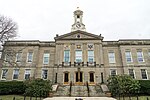Waltham station
Buildings and structures in Waltham, MassachusettsFormer Boston and Maine Railroad stationsMBTA Commuter Rail stations in Middlesex County, MassachusettsRailway stations in the United States opened in 1843

Waltham station is an MBTA Commuter Rail station in Waltham, Massachusetts. It serves the Fitchburg Line. It is located in downtown Waltham adjacent to Central Square (Waltham Common). The station is the transit hub of Waltham, with MBTA bus routes 61, 70, 553, 554, 556, and 558 stopping on Carter Street adjacent to the station.
Excerpt from the Wikipedia article Waltham station (License: CC BY-SA 3.0, Authors, Images).Waltham station
Carter Street, Waltham
Geographical coordinates (GPS) Address Nearby Places Show on map
Geographical coordinates (GPS)
| Latitude | Longitude |
|---|---|
| N 42.374197222222 ° | E -71.236311111111 ° |
Address
Tap Tap Station Cafe
Carter Street 3
02454 Waltham
Massachusetts, United States
Open on Google Maps










